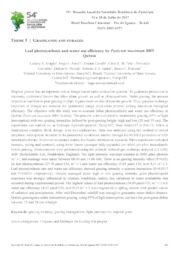Leaf photosynthesis and water use efficiency by Panicum maximum BRS Quênia.
Leaf photosynthesis and water use efficiency by Panicum maximum BRS Quênia.
Author(s): ARAGÃO, L. S.; ASSIS, H. F.; CAVALLI, J.; TESK, C. R. M.; CARVALHO, P.; PEREIRA, D. H.; SCHIMITD JUNIOR, R. J.; PEDREIRA, B. C. e
Summary: Tropical grasses has an important role at forage-based cattle production systems. To guarantee production is necessary understand factors that allow plant growth, as well as photosynthesis. Under grazing, the amount of residual leaf area in post-grazing or plant organic reserves also driven the growth. Thus, gaseous exchange responses in forages are essential for understand forage production process, aiming maximum biological efficiency. The objective with this study was to evaluate foliar photosynthesis and water use efficiency in Quênia (Panicum maximum BRS Quênia). The pastures were submitted to intermittent grazing (95% of light interception) with two grazing intensities defined by post-grazing height: high and low (20 and 35 cm). The experiment was carried out at Embrapa Agrossilvipastoril, Sinop/MT, from March/15 to Feb/16, follow a randomized complete block design, with tree replications. Data was analyzed using the method of mixed templates, with special structure in the parametric covariance matrix, through the MIXED procedure of SAS statistical software. To choose covariance matrix, the Akaike information was used. Three seasons are evaluated (autumn, spring and summer), using three leaves (younger fully expanded per tiller) per plot, immediately before grazing. Measurements were performed using the portable infrared gas exchange analyzer (LCi-SD, ADC BioScientific Ltd., Hoddesdon, England). The light intensity was kept constant at 2000 μmol photons m-2 s-1, and readings were taken between 08:30 and 11:00 AM. There is no grazing intensity effect (P>0.05) on leaf photosynthesis (27.76 μmol CO2 m-2 s-1) and water use efficiency (5.65 μmol CO2 mol H2O m-2 s-1). Leaf photosynthesis rate and water use efficiency showed grazing intensity x seasons interaction (P=0.0317 and P=0.0215, respectively). Despite managed under high or low grazing intensity, grass physiological responses was strongly influenced by climatic conditions, mainly due variations in water availability that occurred during experimental period. The highest values of leaf photosynthesis (34.09 μmol CO2 m-2 s-1) and water use efficiency (4.13 μmol CO2 mol H2O m-2 s-1) were registered in spring, season with greater values of radiation and precipitation. After mid-December, rainfall was enough to guarantee water deficit absence. Quênia guineagrass under intermittent grazing, using 95% of light interception, can have the post-graze define between 35 and 20 cm of height.
Publication year: 2017
Types of publication: Abstract in annals or event proceedings
Observation
Some of Embrapa's publications are published as ePub files. To read them, use or download one of the following free software options to your computer or mobile device. Android: Google Play Books; IOS: iBooks; Windows and Linux: Calibre.
Access other publications
Access the Agricultural Research Database (BDPA) to consult Embrapa's full library collection and records.
Visit Embrapa Bookstore to purchase books and other publications sold by Embrapa.

